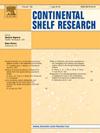Spatial variations and controlling factors in phytoplankton composition at deep chlorophyll maxima in the Bay of Bengal
IF 2.2
3区 地球科学
Q2 OCEANOGRAPHY
引用次数: 0
Abstract
The occurrence of deep chlorophyll maxima (DCM) in the stratified oceanic regions is reported either due to photoacclimation or the availability of nutrients. The influence of mesoscale processes, such as eddies, on the depth of DCM, phytoplankton composition, and the fate of phytoplankton pigments in the Bay of Bengal is unclear. Based on the in-situ observations in the water column, the role of eddies on spatial variability in the depth of DCM and phytoplankton composition was studied. The depth of DCM varied between 20 and 80 m. It was shallowed and deepened in the cyclonic (CE) and anticyclonic (ACE) eddy regions by 20–40 m due to convergence and divergence, respectively. The depth of DCM displayed a significant linear relationship with nutricline and an inverse relationship with the percentage of surface photosynthetic active radiation (PAR) reaching the depth of DCM. The chlorophyll-a (Chl-a) concentration in the DCM varied between 0.2 and 1.1 mg m−3 and was inversely related to the PAR reached and nutrient concentrations at this depth. Prymnesiophytes, chlorophytes, cyanobacteria and prochlorophytes significantly contributed to the phytoplankton in the DCM, but their contribution varied with the amount of PAR received and nutrient concentrations at the DCM. The biomass of prymnesiophytes and chlorophytes increased with an increase in PAR and nutrients at DCM and contrasted with that observed for cyanobacteria and prochlorophytes. The dominance of prymnesiophytes and chlorophytes was observed in regions where shallow (<40m) DCM was present. Cyanobacteria and prochlorophytes were abundant in areas with deep DCM, due to variable light adaptations. Some physical processes bring phytoplankton in the DCM to the surface, and to examine its fate, a microcosm experiment was conducted by incubating DCM waters under surface light. The microcosm experiments suggested that premnesiophytes and chlorophytes decreased by 85–90 %, whereas a 65 % decrease was noticed in the case of cyanobacteria and prochlorophytes from that of the initial. This suggests an increase in Chl-a, after intense physical mixing, may be due to new production arising from nutrients upwelling. The numerical models simulate the depth of DCM, but the composition of phytoplankton groups can be simulated using the governing factors derived in this study to evaluate their role in primary and export production and carbon sequestration in the stratified ocean.
孟加拉湾深层叶绿素最大值浮游植物组成的空间变化及其控制因素
据报道,在分层的海洋区域,深叶绿素最大值(DCM)的发生可能是由于光驯化或营养物质的可用性。中尺度过程(如漩涡)对孟加拉湾DCM深度、浮游植物组成和浮游植物色素命运的影响尚不清楚。在水柱现场观测的基础上,研究了涡旋对DCM深度和浮游植物组成空间变异的影响。DCM深度在20 ~ 80 m之间。气旋涡旋区和反气旋涡旋区分别因辐合和辐散作用变浅20 ~ 40 m和加深20 ~ 40 m。DCM深度与营养线呈显著的线性关系,与达到DCM深度的表面光合有效辐射(PAR)百分比呈显著的反比关系。DCM中叶绿素-a (Chl-a)浓度在0.2 ~ 1.1 mg m - 3之间变化,与该深度的PAR和养分浓度呈负相关。原水生菌、绿藻、蓝藻和原绿藻对DCM浮游植物的贡献显著,但其贡献随DCM吸收PAR量和营养物浓度的变化而变化。与蓝藻和原绿藻生物量相比,原绿藻生物量随PAR和养分的增加而增加。在浅层(40米)DCM存在的地区,原水生植物和绿藻占优势。由于不同的光适应,在深DCM地区蓝藻和原绿藻丰富。一些物理过程将DCM中的浮游植物带到水面,为了研究它们的命运,我们在水面光照下对DCM水域进行了微观实验。微观环境实验表明,藻前菌和绿藻减少了85 ~ 90%,蓝藻和原绿藻减少了65%。这表明,经过强烈的物理混合后,Chl-a的增加可能是由于营养物质上涌产生的新产物。数值模型模拟了DCM的深度,但可以利用本研究导出的控制因子模拟浮游植物群的组成,以评估它们在分层海洋的初级和出口生产以及碳固存中的作用。
本文章由计算机程序翻译,如有差异,请以英文原文为准。
求助全文
约1分钟内获得全文
求助全文
来源期刊

Continental Shelf Research
地学-海洋学
CiteScore
4.30
自引率
4.30%
发文量
136
审稿时长
6.1 months
期刊介绍:
Continental Shelf Research publishes articles dealing with the biological, chemical, geological and physical oceanography of the shallow marine environment, from coastal and estuarine waters out to the shelf break. The continental shelf is a critical environment within the land-ocean continuum, and many processes, functions and problems in the continental shelf are driven by terrestrial inputs transported through the rivers and estuaries to the coastal and continental shelf areas. Manuscripts that deal with these topics must make a clear link to the continental shelf. Examples of research areas include:
Physical sedimentology and geomorphology
Geochemistry of the coastal ocean (inorganic and organic)
Marine environment and anthropogenic effects
Interaction of physical dynamics with natural and manmade shoreline features
Benthic, phytoplankton and zooplankton ecology
Coastal water and sediment quality, and ecosystem health
Benthic-pelagic coupling (physical and biogeochemical)
Interactions between physical dynamics (waves, currents, mixing, etc.) and biogeochemical cycles
Estuarine, coastal and shelf sea modelling and process studies.
 求助内容:
求助内容: 应助结果提醒方式:
应助结果提醒方式:


